Congratulations! You’ve taken the Transcendental Meditation (TM) course and have been practicing for a few weeks, months, or years—or perhaps you’re just getting back to your practice now. Wherever you are on your TM journey, you may be wondering if there’s a summary of some of the most important points to remember as a meditator. Well, now there is!

Personal TM Checking re-establishes effortless TM practice
We’ve gathered frequently asked questions into this TM Primer. Once you’ve read through the Q&A, review your understanding with this easy TM Quiz.
More questions? Just speak directly with a TM teacher. Feeling like it’s time for an in-person TM refresher? Make an appointment for a personal TM Checking, or attend a TM Refresher Course, a group meditation, or an Advanced Knowledge Meeting—all of which are complimentary and part of your TM Course. Find your TM Center ►
Below are 10 common questions to refresh your understanding. You are also welcome to leave a comment below, and a TM teacher will get back to you.
Once you’ve read through the Q&A, review your understanding with this easy TM Quiz.
Bonus feature: Watch this fun video (5:46) from Buzzfeed highlighting the experiences of four people who have just learned TM.
1. What are the best times of day to meditate?
The most important thing is to meditate twice a day. The best times to meditate are once in the morning and once in the afternoon or evening.
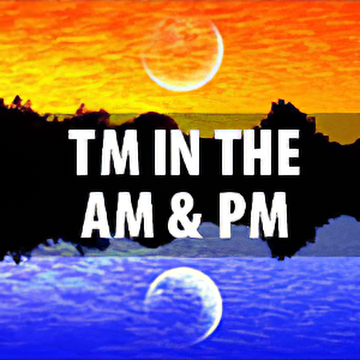
The best time to meditate is twice a day, morning and evening
For most people, we recommend that you meditate soon after waking up—before the never-ending onslaught of emails, texts, phone calls, and daily responsibilities begins.
Having said that, Robyn Field, a full-time mom and part-time professional photographer says: “My mom duties start from the second I wake up: making breakfast, preparing lunchboxes, getting everyone dressed and armed with their school work and off to the buses. Suddenly, the house is quiet. I put the phone in airplane mode, slip into my favorite chair, and dive within.”
In other words, find the best times for you and your schedule.
A few reminders: It’s best to meditate before rather than after a full meal, such as breakfast or dinner. If you’re hungry, it’s fine to have a light snack before meditating. It’s also better to meditate before rather than after you have caffeinated beverages.
And if a vigorous workout is part of your morning or afternoon routine, it’s better to meditate before rather than right after you work out, or to allow time for your body and metabolism to cool down.
See 20 Tips for TM Twice a Day for ideas on how to fit your TM practice into a busy schedule. To learn more about the scientific research on the benefits of twice-daily practice, see the self-paced slide show The Benefits of Regular, Twice-Daily Meditation.
The most important thing is to meditate twice a day. The best times to meditate are once in the morning and once in the afternoon or evening.
2. Does TM twice a day really make a difference? What if I don’t have 20 minutes?
Research has shown that regularity of TM practice—twice a day for 20 minutes for most adults—offers much greater benefit than meditating less.
As Dr. David Orme-Johnson, one of the world’s leading researchers on the Transcendental Meditation technique, explains: “Multiple studies have shown that the benefits from the TM technique are directly proportional to regularity of practice. These include: greater decrease in neuroticism, heart attacks, strokes, and even death. Regular TM practice also leads to greater gains in autonomic stability (an indicator of less stress), resilience, intelligence, and sociability.” Learn more in his article, How Important Is It to Practice TM Regularly? What the Research Tells Us.

Make an appointment with yourself for your TM session
The best length of time to meditate is the time you were instructed by your TM teacher, which is usually 20 minutes for adults. In addition, be sure to take enough time to come out slowly before returning to activity. This routine offers the right balance of the deep rest of TM with daily activity.
If you don’t have 20 minutes, meditate as much as you can, even 10 or 15 minutes, rather than skipping your meditation entirely, then finish later. Or try rescheduling, such as in the afternoon on a work break or later that evening when you get home. The busiest times are when you need it the most!
Many people find that it helps to schedule their TM sessions as appointments “with my Self” every day, such as “6:00 to 6:30 a.m.: TM to start the day” and “5:00 to 5:30 p.m.: TM to recharge.” This ensures they make time to meditate.
See Too Busy to Meditate? Think Again for more on this perennial question, and 20 Tips for TM Twice a Day for how to fit TM into a busy schedule.
If you don’t have 20 minutes, meditate as much as you can, even 10 or 15 minutes, rather than skipping your meditation entirely, then finish later… The busiest times are when you need it the most!
3. How can I avoid interruptions while I’m meditating?
The basic principle is to prevent interruptions in advance.
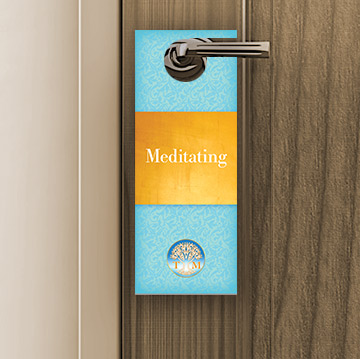
Let family and colleagues know you’ll be meditating with this door card
Before you start meditating, turn off your phone or put it in airplane mode. This is your 20 minutes—your time to de-stress, recharge, and reconnect with your best Self.
Post a sign on your door to notify anyone who might drop by your office or home that you’re meditating. Here’s a door card (front and back) that you can download and print out.
At home, let family members know you are going to be meditating. Arrange for any young children to be taken care of in another room, and put your pets in a different space before you sit to meditate.
In rare cases when interruptions do occur, take a moment to come out slowly before getting up to address the situation. Then return and finish your meditation.
Before you start meditating, turn off your phone or put it in airplane mode. This is your 20 minutes—your time to de-stress, recharge, and reconnect with your best self.
4. What is the ideal position for meditating? Is it OK to meditate lying down?
The first step in getting ready to meditate is to sit comfortably. No special position is required or recommended. Sitting up comfortably is all that’s required. This may be on a chair, couch, bed, or wherever you are most comfortable.

Sitting comfortably is all you need for TM®
While traveling, you can sit and meditate on a bus, train, or plane, or on a park bench or beach blanket.
Though it’s not necessary to sit in any particular position to practice TM, we don’t meditate lying down. This is because the body is accustomed to falling asleep in a prone position.
Meditate sitting up, but feel free to lie down afterwards if you wish and have time.
You also don’t need to remain still or in one position while practicing the TM technique. Feel free to change your position as needed, such as to cross or uncross your legs, scratch, or move your hands. The main principle is comfort.
Meditate sitting up, but feel free to lie down afterwards if you wish and have time.
5. What should I do if I feel sleepy during meditation?

During TM® the body takes what it needs
During the deep rest experienced with the TM technique, the physiology takes what it needs to get rid of stress.
If you have a build-up of fatigue, you might even fall asleep during meditation, which is fine. This is a sign that your body is releasing fatigue.
When we fall asleep during meditation, we simply sit up and finish meditating when we wake up.
Do you frequently feel sleepy during meditation? If so, you may need more sleep than you’re getting. Try to arrange your schedule so that you’re getting more rest at night.
During the deep rest experienced with the TM technique, the physiology takes what it needs to get rid of stress.
6. Can I meditate even in a noisy place? What if I live in a noisy household?
The TM technique is an easy, effortless mental technique, so we can practice it wherever we can sit comfortably with eyes closed. Whenever possible we choose a quiet place, but we can meditate successfully even if it’s somewhat noisy, such as on an airplane or in a public place.
Noise is not a barrier to easy, effortless TM practice. If your attention gets drawn out by noise or a disturbance, just easily return to the practice.
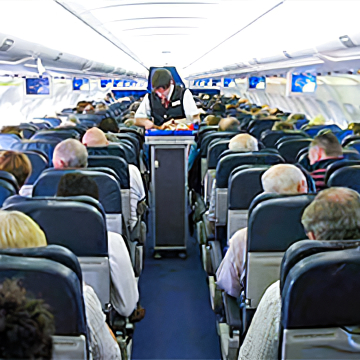
Because TM practice is effortless, noise is not a barrier
Just letting family members and housemates know that you’re going to meditate for 20 minutes will often lead to the household settling down. Some meditators also prefer meditating before others get up in the morning or before everyone gets home in the evening, or at their office before they leave work.
If you ever find it difficult to meditate due to noise or for any other reason, make an appointment with a TM teacher for free TM Checking or attend an Advanced Knowledge Meeting with a group TM Checking at your TM Center. These complimentary support programs are the best way to easily re-experience and re-establish effortless TM practice. Find your TM Center ►
For tips on where to meditate when you’re away from home, see 20 Places to Meditate on the Go—which also includes lots of great ideas and stories from fellow meditators.
Whenever possible we choose a quiet place, but we can meditate successfully even if it’s somewhat noisy. Noise is not a barrier to easy, effortless TM practice.
7. What makes the TM technique so easy?
The TM technique is effortless because it utilizes the natural tendency of the mind to move spontaneously towards greater happiness.

The TM technique utilizes the natural tendency of the mind to move towards greater happiness
Maharishi Mahesh Yogi, the Founder of the TM program, explains effortlessness in this way: “The principle of Transcendental Meditation is simple: Being is bliss in its nature. It is infinite happiness. The mind is always moving in the direction of greater happiness. It is the experience of everyone that wherever the mind goes, it moves in the direction of greater happiness. And because the nature of inner Being is bliss, infinite happiness, during Transcendental Meditation the mind takes that inward course in a most spontaneous manner.”
Maharishi goes on to explain how the mind effortlessly experiences finer levels of thought through the use of the mantra. You can watch his talk here: “Being Is Bliss: The Secret behind Why TM Is Easy” (2:50) ►
If you’re unsure whether your TM practice is easy and effortless, just make an appointment with a Certified TM Teacher for free TM Checking. This enjoyable process usually takes about 30 minutes and is the best way to re-experience and re-establish effortless TM practice. Find your TM Center to make an appointment for free TM Checking ►
“Because the nature of inner Being is bliss, infinite happiness, during Transcendental Meditation the mind takes that inward course in a most spontaneous manner.” —Maharishi
8. Is the TM technique really that different from other forms of meditation?
Yes, it really is. The TM technique is different from other techniques in many ways, but here are three in particular:
- It is simple and easy to practice.
- It gives the experience of a unique neurophysiological state of restful alertness and brainwave coherence.
- Its effects have been scientifically researched in hundreds of published studies showing benefits for health, intelligence, creativity, work, relationships, and more.
Here we’ll just take a closer look at ease of practice.
Unlike other forms of meditation, the TM technique is completely effortless. This means it does not involve any concentration or control of the mind, or any contemplation or monitoring of thoughts.
Scientists categorize TM as a type of meditation called Automatic Self-Transcending because it allows the mind to settle down and experience quieter levels of awareness spontaneously and effortlessly. The two other categories of meditation—Focused Attention (e.g., concentration) and Open Monitoring (e.g., contemplation)—involve mental effort. Mindfulness meditation includes both these approaches.
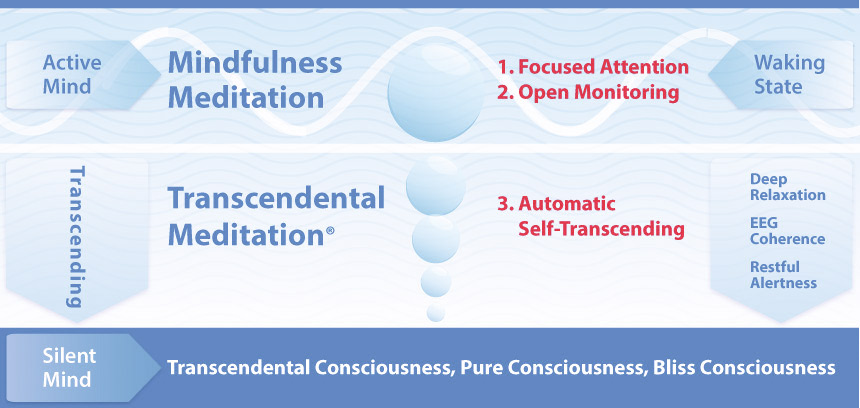
Three Types of Meditation. Focused Attention and Open Monitoring are at the top of the chart because they operate at the active level of the mind and require some degree of mental effort. The TM technique, or Automatic Self-Transcending, allows the mind to effortlessly and spontaneously settle down to quieter, subtler levels to experience the silent mind, the fourth state of consciousness, Transcendental Consciousness.
To find out more about the unique effortlessness of the TM technique from a scientist’s perspective, see Dr. Orme-Johnson’s How Does TM Differ from Mindfulness?
The TM technique also shows a unique brainwave signature not seen in other techniques. Neurologists have found that during TM practice, the activity in the brain’s default mode network increases, which is an indication that the mind is not focusing. In other forms of meditation this kind of brain activity decreases, indicating mental focus and effort. For more on this neurological signature of effortless TM practice, see New Research: Effortlessness Is Key to TM Technique.
Unlike other forms of meditation, the TM technique is completely effortless. This means it does not involve any concentration or control of the mind, or any contemplation or monitoring of thoughts.
9. Are there free support services for my TM practice? Where can I find them?
Yes! Once you’ve completed the four-day TM Course, you can take advantage of your lifelong follow-up program, which is included as part of your course. Maharishi designed TM follow-up to ensure that everyone who learns the technique gains maximum benefits from their daily practice for years to come.
Follow-up programs are provided regularly, free of charge, at most TM Centers across the United States. You’re welcome to participate in follow-up at any TM Center. If you plan to attend a program at a TM Center for the first time, we recommend calling or emailing ahead of time to let the local TM teachers know. Find a TM Center near home, work, or where you’re traveling ►
The goal of all the follow-up programs is to enhance your understanding and experience. These programs are especially valuable as your practice deepens and matures over time.
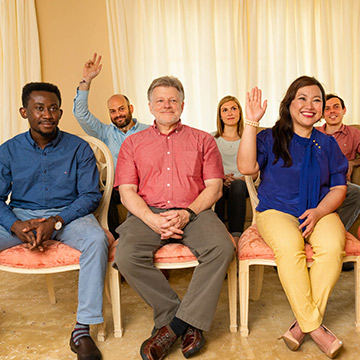
Meditators enjoying an Advanced Knowledge Meeting at a local TM Center
Personal and Group TM Checking: Give your meditation a regular tune-up to ensure it’s easy, effortless, and correct. A Certified TM Teacher guides you through a simple procedure that re-establishes effortlessness in meditation, leading to maximum results. Contact your local TM teacher to set up an appointment.
TM Refresher Course: Review your four-day TM Course in an hour or two for free with a Certified TM Teacher. This single-session overview covers the dos and don’ts of correct meditation, the mechanics of the practice, and how to handle common experiences that occur during TM. The session includes plenty of time for your questions about personal experiences, plus a group checking of your TM practice. Contact a TM Center about the next TM Refresher Course nearby.
Advanced Knowledge Meetings and Special Events: Gain deeper knowledge, enrich your personal growth, and connect with other TM meditators. Advanced Knowledge Meetings and special events usually include a group meditation and TM Checking, discussion of experiences, and special videos or guest speakers presenting a wide range of topics for personal development. Get on the mailing list for your TM Center, and check out local schedules online.
Global TM Group Meditations: Have you ever wondered what it would be like to meditate in a large group, say of 100,000 people? Well, now you can! By popular demand, Global Group Meditations are available at TM Centers in the United States. Meditators report that large Group Meditation is profound and enjoyable, creating a deep sense of happiness, inner peace, and revitalization. Events include a video, conference call, or guest speaker, plus refreshments and a chance to meet other meditators.
Follow-up programs are provided regularly, free of charge, at most TM Centers across the U.S. and worldwide.
Find a TM Center near home, work, or where you’re traveling ►
10. I started TM for stress reduction. What’s the deal on higher states of consciousness and enlightenment?
Peak performance. Being in the zone. Living life at our highest potentiality. You may remember rare moments in your life in which the stress, worries, and doubts faded away and you experienced a deep, blissful inner peace and excelled beyond your expectations. These are glimpses into higher states of consciousness, in which we enjoy a richer, more complete experience of life.
Some of the most wonderful descriptions of such moments come from athletes. Here’s one of our favorites, from Billie Jean King, winner of 20 Wimbledon and 39 Grand Slam titles and one of the greatest athletes of all time:
“That perfect moment happens in all sports… It’s a perfect combination of a violent action taking place in an atmosphere of total tranquility. My heart pounds, my eyes get damp, and my ears feel like they’re wiggling, but it’s also just totally peaceful… And when it happens, I want to stop the match and grab the microphone and shout, ‘That’s what it’s all about.’ Because it is. It’s not the big prize I’m going to win at the end of the match or anything else. It’s just having done something that’s totally pure and having experienced the perfect emotion… ” —Billie Jean King, Billie Jean (1974)
How can practicing the TM technique help us develop and stabilize such peak experiences? Here’s how it works.
The three states of consciousness we experience every day are waking, dreaming, and sleeping. During TM practice, we experience a fourth state that’s different from these: Transcendental Consciousness. Scientists have discovered that this fourth state is a unique neurophysiological state of restful alertness, where the mind is awake and the body is in deep rest. See How Transcending Optimizes Your Brain.

With regular practice of the TM technique and the release of stress, we grow in the fullest value of life and human development
Over time, with regular twice-daily practice of the TM technique, our nervous system gradually becomes free of stress and that state of Transcendental Consciousness is never lost: We spontaneously maintain that inner wakefulness and silence along with waking, dreaming, and sleep. This is called Cosmic Consciousness, the fifth state of consciousness and the first stage of enlightenment. See What Is Cosmic Consciousness?
This is a state of self-actualization and self-realization in which we’re completely free from stresses and limitations and experience the full value of life.
“Enlightenment means lack of darkness, absence of darkness,” Maharishi has said. “And ‘absence of darkness’ means no mistakes, no weakness, no shortcoming, success everywhere, fulfillment of desire everywhere. That is enlightenment. One is living in full accord with Natural Law. Spontaneously, nature is supporting us: then we are not in the dark about anything.”
Higher states of consciousness are associated with increased creativity and intelligence, expanded awareness and wholeness, and greater joy and achievement. Practicing TM accelerates the growth of these values, which become permanent in enlightenment.
To learn more about the development of higher states of consciousness and enlightenment, attend an Advanced Knowledge Meeting at your local TM Center or a One-Day or longer TM Retreat. To find out more, read Maharishi’s classic text the Science of Being and Art of Living and Dr. Tony Nader’s One Unbounded Ocean of Consciousness: Simple Answers to the Big Questions in Life.
Higher states of consciousness are associated with increased creativity and intelligence, expanded awareness and wholeness, and greater joy and achievement. Practicing TM accelerates the growth of these values, which become permanent in enlightenment.
Would you like to share your experiences of transcending during your TM practice or of growing experiences of Cosmic Consciousness in your life? We are collecting written experiences from TM Meditators around the world and would like to include yours. Please note: We never share any information without your expressed permission. If you’d like to share your experience, let us know in a Comment at the end of this article, and we’ll contact you.
Now You’re Ready to Take the Quiz…
To reinforce your understanding, take this TM Quiz. More questions? We’re here to help!
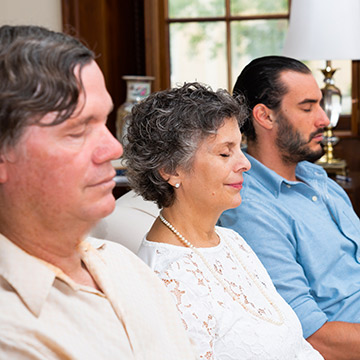
Group meditation at an Advanced Knowledge Meeting
To take your experience and understanding even further, attend an Advanced Knowledge Meeting with group TM Checking and a chance to ask questions. Find your TM Center or a One-Day or longer TM Retreat.
To re-experience and re-establish effortless meditation, make an appointment for free personal TM Checking or attend a free TM Refresher Course. Find your TM Center here ►
For more answers, see Frequently Asked Questions. You’re also welcome to leave a comment below, and a TM teacher will get back to you.
Enjoy your TM practice. Keep meditating easily, twice a day. And watch your life unfold in greater health, happiness, and fulfillment.
To reinforce your understanding, take this TM Quiz. More questions? We’re here to help!






I had the TM course in Atlanta in 1974(?). I practiced TM for some time. But quit later. Now, I have moved to Phoenix, AZ. I would like to get back to practicing. Any suggestions? Do I need refresher??
That’s wonderful to hear, Venkateswara! Yes, it would be great to have a TM refresher with your local TM teachers in Phoenix. Just give them a call and you can make an appointment for a Personal TM Checking meeting, or to attend a TM Refresher Course. Pratima Thakar is the Director of the Phoenix TM Center and may be reached at (480) 900-9001 or phoenix@tm.org. Enjoy reconnecting with your TM practice!
In section 8 (Is the TM technique really that different from other forms of meditation?) I think you should also emphasize that unlike other forms of meditation, a great advantage of the TM program is that it specifies 15-20 minutes 2 times a day, nothing more or less. Most other systems specify much longer periods of practice, which most people don’t follow. Actually this along with the scientific research were the main reasons that got me started practicing regularly some decades ago.
Thank you for this great point, Eustace. Maharishi designed the TM program to be an ideal balance of the deep restful alertness of 20 minutes of TM twice a day with dynamic activity, not only to accommodate busy, modern life but also as the best way to unfold our full potential and establish that inner silence and expansion along with activity. Maharishi talks about this here: https://enjoytmnews.org/the-time-tested-formula-to-develop-cosmic-consciousness-rest-and-activity/
I started meditation 45 years ago to deal with stress and anxiety. It allows my mind to experience quiet awareness without thinking of anything . . . The experience of quiet awareness allows my mind to truly relax. This quiet becomes a part of me even during my waking life.
Thank you for sharing your TM experiences, Mark. This is exactly what Maharishi describes, that the inner silence and settled awareness that we experience during our TM practice gets more and more established and carries over into our activity. A beautiful expression of this.
I am faithful to meditating every morning, but I have not been so committed to the second meditation time every day, even though I know it would benefit me greatly. After reading this article, I am inspired to make a second time for TM every day a priority to my well-being.
That’s great to hear, Cathy! Once your second TM session has became second nature in your day, you’ll reap the added benefits—and wonder how you ever managed without it! Thank you for your comment and all best wishes for 2022.
A question: my “day” goes from 6pm to noon the next day. Story has always been twice a day before daybreak — I get 2 programs done a day, but second one not always before daybreak. I’m trying to get out of this schedule and eventually will. Ok?
This is a great routine for your schedule, Brad. You’ve found the right balance between regular TM practice twice a day and the hours of your activity. The main thing is twice a day, at the beginning of your day’s activity, and again later before “dinner” (whenever that is). Well done!
Wow, great and well written article, Harbour, which continues to remind me how important, and how much, TM has continued to help me in life. I had the honor of having “My Story” featured in your magazine, and as I mentioned in it, if it wasn’t for TM I would not be living my life to the fullest as I am doing now. It has been one of my best tools in helping me overcome the PTS that I experienced a few years ago in a major fire, and if it wasn’t for TM I don’t think I would be here now. Again, what a great informative article to remind me how blessed I am to have learned TM back in 1977.
Belated thanks for your kind words, Ted, and MOST of all for your wonderful My Story and ongoing inspiration to all of us! Take care, and keep on trekking!
I have been practicing TM since 1975 and the TM-Sidhi program since 1980s. A nice article to remind me what an amazing journey its been and how this simple practice helped to advance my levels of creativity and everyday happiness! You gain more insight into Adi Shankara’s sayings “I am Consciousness, I am Bliss..”
I’ve recommended TM to my family and many of my patients. JGD
Thanks for your wonderful comment, Dr. Schwartz! Truly an amazing journey, of everyday happiness and expanding creativity…
I get into a state. I’m not sure if it is sleeping or not. From that state I remember only that I was conscious and felt good – I have no memory of what I was thinking (if anything).
Thank you, Connie, for sharing your experience of deep silence and inner awareness. This is transcending, when the mind is fully awake without any thoughts, just pure consciousness and even bliss. This happens spontaneously when we meditate, in brief moments or longer, whether clear or hazy. With regular meditation this inner awareness keeps growing over time. Thanks for your comment!
Best way for my self …mai apne apko samaz parahi… muze positive feeling ho rahi hai. What I think? oh sub mere sawaloka jawab muze mill raha nature say.
Thank you, Archana. Is this translation correct? “Best for my self… I am on my own… I am feeling positive.
What do I think? I am getting answers to my questions from Nature.” Thank you for your comment!
What a great article! Even for someone who has been doing the TM and TM Sidhi program day in and day out for almost 50 years, it’s so good to be reminded of these simple principles at the heart of our practice. My life has been immeasurably changed because of TM. Everyone in my extended family meditates and many friends. What a blessing. Jai Guru Dev.
Thank you Donald! You put it so beautifully, the gift of this simple and powerful practice. All best wishes to you and your family!